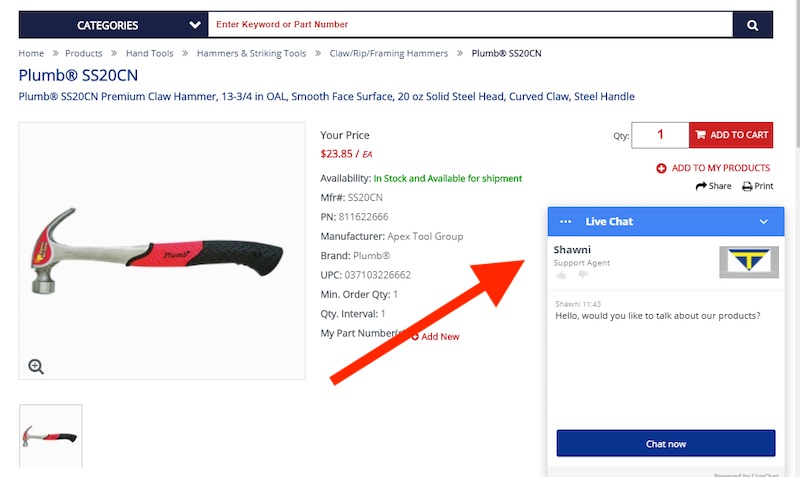
Business buyers often have complex questions about products, delivery, payment terms, and more. Live chat is critical for B2B ecommerce success. Image: Turner Supply.
Live chat is arguably more important for B2B sites than for B2C. The B2B purchasing process is typically complex. Buyers frequently have questions. Increasingly, they expect a live-chat function for real-time conversations.
For merchants, live chat is an effective form of communication. You know a bit about whom you are talking with. For example, you could see how the user got to your website, what he viewed, where he is located, and even what he is typing in the chat box before sending.
In short, if you are serious about capturing new business, live chat is critical. In this article, I will review the basics of building a successful live chat program.
There are three primary reasons to have a live chat program in my experience. First, it can increase conversions and sales. Second, it enables improved customer service. The third reason is often overlooked: Live chat identifies areas of improvement, such as confusing product descriptions, broken links, and mistakes.
Implementing Live Chat
1. Research.
- Analyze competitors. How are competitors using live chat? Pretend you are a potential customer. Engage in live chat conversations. See how well they respond to your queries. Did they lead you to certain outcomes? You can learn a lot by simply exploring live chat on competitive websites.
- Understand your visitors. Who are they? Why are they there? What do they want? Answers to these questions can help prepare your team for future chats.
- Define your goal. What you are trying to achieve with live chat? More sales? Faster responses to customer queries? Have a single goal with several measurable objectives.
2. Train staff. From my experience, the quality of training will reflect the success of live chat. Training should not be a one-time event. It’s an on-going effort. Start with four parts. Then customize to fit your business.
- Why live chat? Make sure your team understands the strategy behind live chat and what the benefits are. Sharing real-world examples is a good way to help others see and understand the benefits.
- What are we trying to achieve? Communicate the goals and objectives of the program.
- How do we get started? This should include all training topics, such as software, web content, chat types, and best practices.
- How will we track success? Explain the expectations and how you will track and report them.
Once you’ve selected a live chat provider, have multiple training sessions of 30 to 45 minutes each. Explain how to use the software and then have mock chat sessions.
3. Establish KPIs. There are many potential key performance indicators for a live chat program. Start with only a few and add new ones on as you go along.
- Chat availability. Percentage of time a staff member is ready to accept a chat?
- Number of chats. How many chats did you process in a given period — by the entire staff and by each team member?
- Chat statistics. Average chat duration, average wait time, average response time during the chat.
- Conversions. What is a conversion for your site? For B2B ecommerce, conversions often are not a sale. They could be, as examples, downloading product collateral, opening an account, subscribing to a newsletter.
- Customer satisfaction. Most live chat platforms provide a way for users to offer feedback.
- Ratios. Critical ratios include (i) web visitors to chats, (ii) chats to conversions, and (iii) uptime to chats received.
4. Go live.
- Monitor chats closely. Provide frequent feedback to your team. Read chat transcripts to see how your team is performing and to identify changes to improve the program.
- Seek input from your team. Ask them what is working and what is not.
- Tweak and improve. Continue to learn, track, change, and grow.




